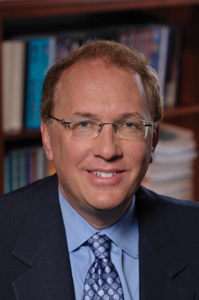
Cardiothoracic surgeon David Taggart (Department of Cardiac Surgery, University of Oxford, John Radcliffe Hospital, Oxford, UK) told delegates attending the 2019 European Association for Cardio-Thoracic Surgery (EACTS) meeting (3–5 October, Lisbon, Portugal) that the definition of myocardial infarction used in EXCEL was incorrect, leading to the wrong conclusion that percutaneous coronary intervention (PCI) is non-inferior, at five years, to coronary artery bypass grafting (CABG) for the management of selected patients with left main disease. Taggart was an EXCEL trial investigator but withdrew his name as an author because of his view on the conclusion.
The five-year outcomes of EXCEL were presented at the 2019 Transcatheter Cardiovascular Therapeutics (TCT) meeting (25–29 September, San Francisco, USA) and were simultaneously published in the New England Journal of Medicine. They showed that PCI with a second-generation drug-eluting stent in selected patients (low or intermediate anatomical complexity) with left main disease was non-inferior to CABG in terms of the primary endpoint of death, stroke, or myocardial infarction at five years. The three-year results were previously presented at TCT and also showed no significant differences between PCI and CABG in the primary endpoint.
However, according to Taggart, the definition of myocardial infarction was changed “halfway through the trial” (“a disgrace”) from the “real” definition of myocardial infarction (30 days’ post procedure) to a biochemical periprocedural one. He stated: “If you look at outcomes at 30 days, the only thing that benefits PCI is myocardial infarction and this was after the change to a biochemical definition that favoured PCI and one that disadvantaged CABG. If you look at outcomes between 30 days and one year, there is no difference. If you look at outcomes between one year and five years, there is a very highly significant difference in the rate of death, myocardial infarction, and repeat revascularisation between PCI and CABG.”
The findings Taggart was referring to are—as reported in the New England Journal of Medicine—as follows:
- 30 days (myocardial infarction): 3.9% for PCI vs. 6.3% for CABG (hazard ratio [HR] 0.53)
- 30 days to one year (myocardial infarction): 1.7% vs. for PCI vs. 1.1% for CABG (HR 1.58)
- One year to five years (death, stroke, myocardial infarction, or ischaemia-driven revascularisation): 22.4% for PCI vs. 13.8% for CABG (HR 1.74)
Furthermore, Taggart told EACTS delegates that Mauro Gaudino (Department of Cardiothoracic Surgery, Weill Cornell Medicine, New York, USA) performed an analysis of the EXCEL data using the non-procedural myocardial infarction (“real myocardial infarction; the one that kills people”) and this showed that “CABG is the clear winner for death, myocardial infarction, and repeat revascularisation at five years”.

However, the principal investigator of EXCEL Gregg Stone Stone (Zena and Michael A. Wiener Cardiovascular Institute, Icahn School of Medicine at Mount Sinai, New York, USA) told Cardiovascular News that Taggart’s assertion that the definition of myocardial infarction was changed midway through the trial is not true. He adds that the first and last versions of the protocol, which he says “anyone” can download from the NEJM, have “identical” definitions of periprocedural myocardial infarction. According to the document Stone sent to Cardiovascular News, both versions make reference to elevations in cardiac biomarkers being used to define periprocedural myocardial infarction.

Furthermore, Stone notes that Taggart was actually the surgical chairman of the EXCEL study during the design and the recruitment phase. He comments that as a result, Taggart “was intimately involved in all the decisions regarding the primary endpoint definitions, including periprocedural myocardial infarction, and agreed to them”. He adds that Taggart was also an author on a paper in the European Heart Journal that “demonstrated that the biomarker-based definition of large myocardial infarction used as the primary endpoint in EXCEL was strongly and independently related to mortality, at least as strongly after CABG compared with PCI”. Therefore, Stone believes, the claim periprocedural myocardial infarction (with the EXCEL definition) events are meaningless is “groundless”. In his talk at EACTS, Taggart did acknowledge his position as surgical chairman of EXCEL but stated that he withdrew from the recent NEJM paper because he felt that the conclusion was one that was “completely at odds with the actual data”. “I would emphasise that I have never, ever, withdrawn my authorship, in more than 300 publications, before,” he said. Of note, Taggart’s name is on the paper (also published in the NEJM) reporting the three-year results of EXCEL.
Additionally, in his talk, Taggart said that the alleged change in the definition of myocardial infarction was an attempt to manipulate the data to try to prompt a result that did not show a difference between PCI and CABG in the primary endpoint. “For the EXCEL trial to use a periprocedural biochemical definition of myocardial infarction and give it the same weight as a non-procedural myocardial infarction was an absolute outrage. In my 30 years’ of medical practice, I have never witnessed such an attempt to distort what a paper actually looks like,” he claimed. Stone said that both the claim that the data had been manipulated and the claim that the endpoint had been changed were “bizarre and totally erroneous”.
Mortality data
The EXCEL paper, at five years, shows that all-cause death was significantly higher with PCI: 13% vs. 9.9% (odds ratio 1.38). About this finding, Taggart says: “The crucial thing is that it [the difference] is accelerating.” Stone acknowledges that the mortality result may be a “real finding” but says that for multiple reasons—including that “there was no significant difference in cardiovascular mortality, which is what would be expected between two cardiac procedures if one was to improve survival”—is “much more likely” to be a play of chance. “Thus, Dr Taggart’s reliance on one non-powered endpoint, ignoring all the other data in the field and without acknowledgement of the statistical limitations of this finding or the existence of other adverse events, is the definition of cherry picking and is disingenuous,” Stone observed.
Abbott’s involvement in EXCEL
As well as being critical of the conclusion of EXCEL, Taggart commented that one of the authors of the EXCEL was the chief medical officer of Abbott Vascular (Charles Simonton) and that “36% of authors have received personal fees from Abbott Vascular outside of this trial and 42% have received fees from other companies who produce stents”. Rita F Redberg (the editor of JAMA Internal Medicine), who was part of the panel discussion following Taggart’s talk, said that there was a “big problem” when a company not just funds a trial “but is actively involved in the trial; is involved in data analysis”. “If you want to take independent funding [that is fine], but the trial should have an independent analysis. I think this is a big issue for this study. [Company involvement] is a problem with are faced with over and over again,” she said.
Reacting to Redberg’s comments, Stone said: “As stated in NEJM, Abbott participated in the design of the protocol and in the selection and management of the sites. However, it was not involved in the management or analysis of the data or preparation of the manuscript. And while Dr Simonton was appropriately an author reflecting his early efforts in protocol design, he made no comments or revisions to the manuscript. Lastly, I received no personal income from either Abbott or the Cardiovascular Research Foundation during the course of this trial or afterwards.
Cardiovascular News contacted David Taggart about his comments at EACTS and Stone’s response to them. He said: “I stand by everything that I said in my lecture at EACTS—the largest meeting of cardiothoracic surgeons in the world—and have nothing further to add at this stage.“ However, he did say that he and Gregg Stone plan to debate the issue further, in person, at the International Coronary Congress in New York (USA) this December.










